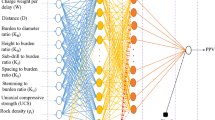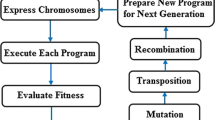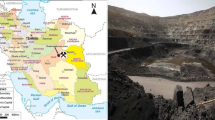Abstract
The blast-induced ground vibration (BIGV) is a severe environmental impact of blasting as it can affect the integrity of the structures and cause civil unrest. In this study, the BIGV of Daejeon tunnel was predicted taking into consideration parameters such as hole length, the charge per delay, number of holes, total charge, distance from the measuring station to the blasting point and the rock mass rating as the input parameters, while the peak particle velocity (PPV) was the targeted output parameter. An artificial neural network (ANN) model was first simulated. The optimum ANN structure obtained was optimized using a novel moth-flame optimization algorithm (MFO). The gene expression program (GEP) was also used to develop another new model. The proposed models were compared with the multilinear regression (MLR) model and the selected empirical models for the PPV predictions. The performance of the proposed model was evaluated using statistical indices such as adjusted coefficient of determination (adj R2), mean square error (MSE), mean absolute error (MAE), and the variance accounted for (VAF). The proposed MFO-ANN outperformed other models with the adj R2 of 0.9702 and 0.9577, VAF of 97.0472 and 95.9832, MSE of 0.0009 and 0.0008, and MAE of 0.0233 and 0.0216 for the respective training and testing phases. The sensitivity analysis was conducted using the weight partitioning method (WPM), and the charge per delay has the highest influence on the predicted PPV. This study indicates the suitability of the proposed models for the prediction of PPV.











Similar content being viewed by others
References
Abdel-Rasoul EI (2000) Assessment of the particle velocity characteristics of blasting vibrations at Bani Khalid quarries. Bull Faculty Eng 28(2):135–150
Akande JM, Aladejare AE, Lawal AI (2014) Evaluation of the environmental impacts of blasting in Okorusu Fluorspar Mine. Namibia Int J Eng Tech 4(2):101–108
Armaghani DJ, Hajihassani M, Mohamad ET, Marto A, Noorani SA (2014) Blasting induced flyrock and ground vibration prediction through an expert artificial neural network based on particle swarm optimization. Arab J Geosci 7(12):5383–5396
Duvall WI, Petkof B (1959) Spherical propagation of explosion generated strain pulses in rock. U.S. Department of the Interior, Bureau of Mines
Fausett L (1994) Fundamentals of neural networks. Prentice Hall, Englewood Cliffs
Ferreira C (2001) Gene expression programming: a new adaptive algorithm for solving problems. Complex Sys 13(2):87–129
Fine TL (1999) Feedforward neural network methodology. Springer, New York
Garson GD (1991) Interpreting neural network connection weights. Art Intel Expert 6:47–51
Goh ATC (1995) Back-propagation neural networks for modeling complex systems. Art Intel Eng 9:143–151
Hagan TN (1973) Rock breakage by explosive. In: Proceedings of the national symposium on rock fragmentation, Adelaide, pp 1–17.
Hagan MT, Menhaj M (1994) Training feed-forward networks with the Marquardt algorithm. IEEE Trans Neu Nets 5(6):989–993
IS 6922 (1973) Criteria for safety and design of structures subject to underground blast. Bureau of Indian Standards (BIS), New Delhi, India.
Khandelwal M, Singh TN (2009) Prediction of blast-induced ground vibration using artificial neural network. Int J R Mech M Sci 46(7):1214–1222
Khandelwal M, Kumar DL, Yellishetty M (2011) Application of soft computing to predict blast-induced ground vibration. Eng Comp 27(2):117–125
Kwon S, Cho WJ, Han PS (2006) Concept development of an underground research tunnel for validating the Korean reference HLW disposal system. Tunnel Under S Tech 21:203–217
Langefors U, Kihlstrom B (1963) The modern technique of rock blasting. Wiley, New York
Lawal AI (2020) An artificial neural network-based mathematical model for the prediction of blast-induced ground vibration in granite quarries in Ibadan, Oyo State. Nigeria Scic African 8:e00413
Lawal AI, Idris MA (2019) An artificial neural network-based mathematical model for the prediction of blast-induced ground vibrations. Int J Env Sts. https://doi.org/10.1080/00207233.2019.1662186
Lawal AI, Kwon S (2020) Application of artificial intelligence to rock mechanics: an overview. J R Mech Geotech Eng. https://doi.org/10.1016/j.jrmge.2020.05.010
Lee C, Joen S (2015) Current status of KURT and its long-term experimental research programme. The 13th International Congress of Rock Mechanics.
Li G, Kumar D, Samui P, Rad HN, Roy B, Hasanipanah M (2020) Developing a new computational intelligence approach for approximating the blast-induced ground vibration. Appl Sci 10:434
Marquardt D (1963) An Algorithm for least-squares estimation of nonlinear parameters. SIAM J Appl Maths 11(2):431–441
Mirjalili S (2015) Moth-flame optimization algorithm: a novel nature-inspired heuristic paradigm. Knowledge-Based Sys 89:228–249
Mirjalili S, Mirjalili SM, Lewis A (2014) Grey wolf optimizer. Adv Eng Soft 69:46–61
Mohammadnejad M, Gholami R, Ramazanzadeh A, Jalali ME (2012) Prediction of blast-induced vibrations in limestone quarries using Support Vector Machine. J Vib Cont 18(9):1322–1329
Monjezi M, Ghafurikalajahi M, Bahrami A (2011) Prediction of blast-induced ground vibration using artificial neural networks. Tunnel Under S Tech 26(1):46–50
Monjezi M, Hasanipanah M, Khandelwal M (2013) Evaluation and prediction of blast-induced ground vibration at Shur River Dam, Iran, by artificial neural network. Neu Comp App 22(7–8):1637–1643
Shakeri J, Shokri BJ, Dehghani H (2020) Prediction of blast-induced ground vibration using gene expression programming (GEP), artificial neural networks (ANNs), and linear multivariate regression (LMR). Arch Min Sci 65(2):317–335
Vasović D, Kostić S, Ravilić M, Trajković S (2014) Environmental impact of blasting at Drenovac limestone quarry (Serbia). Env Earth Sci 72(10):3915–3928
Wolpert DH, Macready WG (1997) No free lunch theorems for optimization. Evol Comp IEEE Trans 1:67–82
Acknowledgment
This work was supported by Korea Research Fellowship Program through the National Research Foundation of Korea (NRF) funded by the Ministry of Science and ICT (2019H1D3A1A01102993 and 2017M2A8A5014857).
Author information
Authors and Affiliations
Corresponding author
Ethics declarations
Conflict of interest
The authors declare that there is no conflict of interest.
Additional information
Communicated by Savka Dineva, PhD (CO-EDITOR-IN-CHIEF).
Rights and permissions
About this article
Cite this article
Lawal, A.I., Kwon, S. & Kim, G.Y. Prediction of the blast-induced ground vibration in tunnel blasting using ANN, moth-flame optimized ANN, and gene expression programming. Acta Geophys. 69, 161–174 (2021). https://doi.org/10.1007/s11600-020-00532-y
Received:
Accepted:
Published:
Issue Date:
DOI: https://doi.org/10.1007/s11600-020-00532-y




